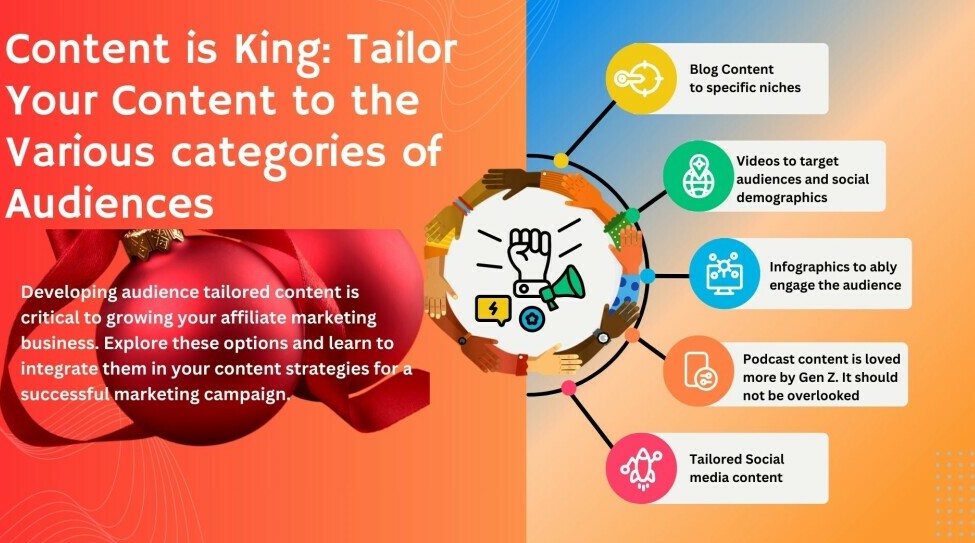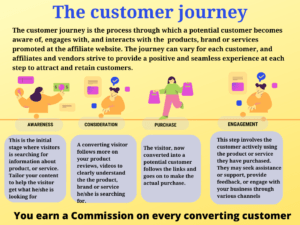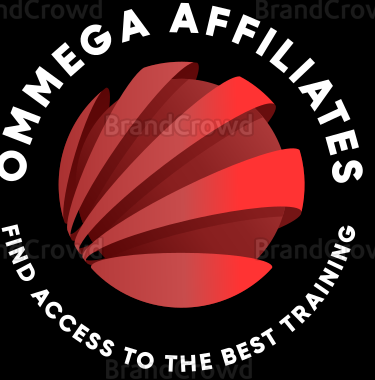Master affiliate marketing success with our proven content strategy tips. Elevate engagement, drive traffic, and amplify revenue with expert tactics for a winning affiliate journey.

Introduction
Hey there! If you have stumbled upon this blog, chances are you are looking to maximize your revenue generation from affiliate marketing. Perhaps. maybe you are just curious about how exactly it all works. Either way, fasten up because we are about to dive deep!
Overview of Affiliate Marketing
Think of affiliate marketing as a virtual salesman, tirelessly bringing in customers 24/7. It revolves around promoting products and earning commissions for every successful sale or lead. Sounds great, right? Well, it needs the right resources and strategies to truly shine.
Importance of a Content Strategy for Successful Affiliate Marketing
Now comes the star of our show – the content strategy. Believe it or not, your content strategy can make or break your success in affiliate marketing. Think about it:
- Strong content attracts more readers.
- The more readers you have, the more potential customers.
- More customers mean more conversions.
- And more conversions? You guessed it – more revenue!
So buckle up, and let’s start building an effective content strategy together!
Understanding Your Target Audience
The success of your affiliate marketing primarily depends on how well you know your audience. Your content strategy will significantly hinge on your understanding of who your targets are.
Identifying Your Target Audience
Start by identifying who your target audience is. Ask yourself questions like who would be interested in your products or services? Who are your current customers? What do they like about your offer? Understanding this demographic can help you create more targeted and effective content that is relevant to:
- Specific Age groups,
- Various Occupations, and
- Interests
Conducting Market Research
Once you’ve identified your target audience, it’s time to dive deeper. Conduct market research to find out more about their online behavior, preferences, and habits. Find out what platforms they use, the type of content they consume, and when they are most active.
Creating Buyer Personas
Finally, turn your research into defined “buyer personas”. These are fictional representations of your ideal customers, based on real data about customer demographics and online behavior. These personas act as a template to help you create more targeted content.
Understanding your audience is a critical first step in developing an effective content strategy for successful affiliate marketing. With a clear understanding of your audience, you are well equipped to create content that resonates, engages, and converts.
Setting Goals and Objectives
A thriving affiliate marketing endeavor starts with clear goals and targeted objectives.
Defining Revenue Generation Goals
Before plunging headfirst into content creation, it’s critical to set realistic revenue generation goals. Look closely at your market scenario, the potential audience, and revenue prospects to formulate what makes sense for your business. This might include:
- Pursuing increased overall sales,
- Up-selling or cross-selling products, and
- Increasing repeat sales.
Setting SMART Objectives
To maximize your affiliate marketing success, align your objectives using the SMART criteria – Specific, Measurable, Achievable, Realistic, and Time-bound. This gives your strategy structure and helps you focus your efforts. For instance, your SMART objective could be to boost organic traffic by 30% in the next six months. These types of goals not only guide your efforts but also offer a clear tactic for measuring success.

Choosing Affiliate Programs
The first crucial step in crafting an effective content strategy for affiliate marketing is to judiciously select the right affiliate programs. This requires thorough research and consideration.
Researching and Selecting Affiliate Programs
Firstly, search for affiliate programs relevant to your niche. These should resonate with your audience’s needs and preferences. You can:
- Explore different affiliate networks to find abundant program options,
- Review the product or service offered by the affiliate for quality and relevance, and
- Understand the reputation of the affiliate company before affiliation.
Evaluating Commission Structures and Payout Terms
After identifying suitable programs, evaluate their respective commission structures and payout terms. Different programs will have diverse commission rates and payment frequencies. Consider:
- The percentage or flat rate of commission per sale,
- The payment method and how frequently you get paid, and
- Possible thresholds for payouts and any potential fees involved.
Opt for programs with favorable terms that have the potential to maximize your revenue generation.
Developing a Content Plan
Content creation is an art. It requires strategic planning and execution. Today, we are going to delve into three crucial steps in developing an effective content plan for successful affiliate marketing. These steps include understanding different types of content, mapping content to the buyer’s journey, and creating a content calendar.

Understanding Different Types of Content
Understanding your content is the first major hurdle. There is no one-size-fits-all answer here; different types of content work for different audiences. Blogs, videos, infographics, podcasts, and social media posts are just a few options. It’s all about knowing what translates best to your target demographic.
Mapping Content to the Buyer’s Journey
Next up, mapping your content to the buyer’s journey. This step involves aligning your content to fit each stage of your customer’s journey: awareness, consideration, and decision. For instance, educational blogs or videos can be great for awareness; product comparisons and case studies might suit the consideration phase, while testimonials and detailed product descriptions can nudge them towards a decision.

Creating a Content Calendar
Finally, organization is key! A content calendar helps to keep track of what you’re posting, when, and where. You can plan seasonal content in advance and keep an eye on important dates and events. This way, you can ensure your content is timely, relevant, and gets the right visibility. With a clear roadmap, you are sure to maximize your revenue generation through affiliate marketing.
Keyword Research and SEO Optimization
Keyword research and SEO optimization are critical factors that can dramatically increase your affiliate marketing success. By understanding and leveraging these components, you’ll ensure that your content is discoverable and appealing to both search engines and your target audience.
Importance of Keywords in Affiliate Marketing
In any form of digital marketing, including affiliate marketing, keywords play a major role. They are essentially what your target audience is searching for online. Hence, to generate revenue and successfully target the right audience, embedding relevant keywords into your website, blog posts, and social media updates is imperative.
Conducting Keyword Research
Keywords are that backbone of quality and useful content. Any affiliate must devote resources and time learning the art of keywords research.
Successful keyword research involves: – Identifying your niche market and assessing what terms they are likely to search for. Utilize keyword research tools, such as Google Keyword Planner, and Jaaxy, among others, to discover what keywords your audience is searching for.
Once you have obtained the keywords your audience is searching for in search engines, the next step will be generating relevant content! For a comprehensive steps on how to perform keywords research and the relevant tools to use, I advise to also read this article.
Creating Engaging and Compelling Content
The success of an affiliate marketing strategy significantly depends on the ability to produce high-quality and engaging content. Let us break it down.
Writing High-Quality and Unique Content
One of the key steps in developing a successful content strategy is crafting high-quality and unique content. This is not just copying words or poorly written texts. Actually, you need to create content that provides value to your audience, answers their questions and piques their interest.
Quality content takes a number of forms: it involves writing blogs, that are boosted with video tutorials, adding e-books or guides, and any other type of content your audience may prefer.
Remember, relevance and originality are the cornerstones of a successful content strategy.
Incorporating Affiliate Links Naturally
You also need to know how to subtly incorporate affiliate links into your content. This should not appear as though you are being forced and it should not be overdone.
The right way of doing this is to naturally weave the links into your content so readers can smoothly flow from your content to the affiliate product without feeling jolted or misdirected.
Remember, the focus is on providing value to your audience, and not just on selling.
Utilizing Storytelling Techniques
Another great way to captivate your audience is by utilizing storytelling techniques in your content. Supposing you are reviewing a product, share your personal experiences with the product/service, narrating success stories, as well as any shortfalls. These storytelling elements make your content more relatable and interesting, increasing the likelihood of conversions and revenue generation. Remember, a well-told story can be a powerful tool for engaging and persuading your audience.
Promoting Your Content
Ultimately, a successful and profitable affiliate marketing endeavor relies heavily on effective content promotion. Incorporating various promotional strategies can help you reach a wider audience, enhance your online presence, and optimize conversions. Let us dive into some of the strategies you can exploit to ensure success of your business:
Leveraging Social Media Platforms
Social media is a powerful ally in your pursuit of affiliate marketing success. These media platforms have billions of active users, which means your business can reach a wider audience and target specific demographics. In pursuit of this strategy;
- use platforms where your target audiences are, and engage with them consistently. Whether it is Facebook, Instagram, Twitter, LinkedIn, or YouTube, understanding the preferences and behaviors of your audience will help you focus your efforts on the platforms that yield the best results,
- build a strong personal brand, whereby you establish yourself as an authority in your niche. Share valuable content, engage with your audience, and showcase your expertise. Consistency and authenticity are key to building trust and credibility among your followers
- engage with your followers through responding to comments, messages, and inquiries promptly. Initiate conversations, ask questions, and encourage discussions to foster a sense of community. Building a loyal and engaged audience is crucial for successful affiliate marketing.
Building an Email List
Another essential strategy in promoting your content is building an email list. By sending regular emails that provide value and build trust, you can create a more personal connection with your subscribers and increase the likelihood of a conversion. With an email list you will be, among others, able to:
- offer freebies or exclusive promotions as incentives for sign-ups,
- personalize emails for better engagement and conversion rates. With email, you can segment your subscribers based on various factors like their demographics, interests, purchase history, or behavior on your website. This allows you to send highly targeted messages to your audience,
- track and measure your results. With email, you can see exactly how your campaigns are performing, which can help you to make data-driven decisions and improve the effectiveness of your marketing efforts,
- to improve on your credibility and trust with your audience. By sending regular, relevant, and valuable emails to your subscribers, you are demonstrating your expertise and building a relationship with them over time, and
- promote new products or services to your audience. With an email list, you have a direct and highly effective channel for communicating with your subscribers and promoting your latest offerings.
Engaging in Influencer Marketing
Leverage the power of influencer marketing by collaborating with relevant influencers in your niche. Seek out for such influencers who align with your brand values and have a substantial following.
Collaborating with such influencers can expose your affiliate offers to a wider audience and drive conversions.
Tracking and Analyzing Performance
Developing a content strategy without tracking or analyzing how it performs may lead to a waste of resources. Here is how to effectively review your content’s performance:
Setting up tracking codes and analytics tools
First things first. You need to equip your website with the right tracking codes and analytics tools. Affiliate marketing platforms usually provide unique tracking codes to trace your conversions.
With tools like Google Analytics, you can track how your content is performing. When using the analytics tools, pay attention to such issues as bounce rate and conversion patterns. Overall, you will be able to identify trends and patterns in how visitors engage with your website.
Analyzing key performance indicators (KPIs)
Now that your tracking codes are in place and data is coming in, it’s time to analyze your KPIs. Monitoring metrics such as the click-through rate (CTR), conversion rate, and revenue generation will guide you on your content’s effectiveness.
Making data-driven improvements
Lastly, review your data and make the necessary improvements. Remember, the target is to create a content strategy that boosts your conversion optimization. So, use the data to fine-tune your content, enhance your audience targeting, and consequently optimize your affiliate marketing strategy.
Conversion Rate Optimization (CRO)
One of your top priorities in affiliate marketing should be to convert as many visitors as possible into buying customers because that is where the real revenue generation begins. As such conversion rate optimization (CRO) is pertinent to the growth of your affiliate marketing business.
Typically, CRO can be defined as the practice of increasing the percentage of users who perform a desired action on a website. Desired actions can include purchasing a product, clicking ‘add to cart’, signing up for a service, filling out a form, or clicking on a link.
To achieve this goal, you can leverage the following strategies:
Conducting A/B Testing
One effective method to optimize conversions is by conducting A/B tests, which means comparing two versions of a website or landing page to see which performs better. Comparing different features like headlines, CTA buttons, or layout can provide valuable insights.
Improving Landing Page Design
The design of your landing page plays a crucial part in conversion optimization. Ensure that it is easy to navigate, visually appealing, and clutter-free. Be sure to highlight your affiliate links or buttons clearly so they draw attention. Ultimately, a well-executed conversion optimization strategy will lead to much higher success in your affiliate marketing endeavors.
Maintaining and Updating Your Content Strategy
Staying competitive in the affiliate marketing arena is not a set-it-and-forget-it proposition. It involves continuous updating and refining of your content strategy. This can be done by:
Regularly Auditing and Refreshing Content
In the first place, your existing content should be audited regularly. This means evaluating its effectiveness, relevance, and how it is meeting the goals set out. Refresh the content to keep up with changing consumer needs, update outdated information, and fix any broken links or error messages. The key points involve: – Keeping up with new keywords and SEO strategies such as:
- checking if your CTAs are still compelling, and
- staying Updated with Industry Trends.
Keep a finger on the pulse of the affiliate marketing industry by staying current with trends. New marketing tactics, customer preferences, and technology can profoundly impact your strategy.
Continuously Optimizing and Refining Your Strategy
Finally, the context in which your strategy operates will continually shift. Keep your content strategy flexible and ready to adapt. Make small pinches and adjustments to optimize conversion rates, audience engagement, and revenue generation. Remember, small changes can have big impacts.
Recap of the Importance of an Effective Content Strategy
In the world of affiliate marketing, an effective and well-planned content strategy plays a paramount role. Remember that a good content captivates, informs, and compels your audience ultimately leading to conversion. Always remember to keep the following up-to-date:
- Always optimize your content keyword for SEO benefits,
- Remember to always promote products that match your audience’s interests, and
- Continuously keep monitoring and optimization of your content as the requirement of you audience change.
Conclusion
Now that you have been armed with these powerful strategies, the next step is to ensure their application. Do not let this information just pile up in your head, but translate these insights into your affiliate marketing strategy. Although at first sight it might seem overwhelming, yet you never forget that, every step forward is a step towards potential success. Start now, enhance your site authority and traffic streams, then you are guaranteed of generating much revenue!
For a comprehensive training in online business, grab this opportunity and enroll for a free starter package with Wealth Affiliate platform today. If you are convinced that it is what you have been looking for, then go ahead to upgrade to a pay option you will like.

I hope you have enjoyed reading these content strategies and if you have any questions or comments, please leave them in the box below and you will be answered within 24 hours.
Thank you.
Cheers
Joseph Hawumba

Fantastic guide! The emphasis on understanding the audience, setting SMART goals, and choosing affiliate programs wisely is spot on. The content plan section, covering different types of content and buyer’s journey mapping, is insightful, and the focus on keyword research and SEO is crucial.
I appreciate the reader-centric approach to writing high-quality content and subtly incorporating affiliate links. The promotion strategies, including social media, email lists, and influencer marketing, offer a well-rounded approach.
The guide’s emphasis on tracking and analyzing performance, coupled with conversion rate optimization through A/B testing and improved landing page design, showcases a data-driven mindset.
The call to regularly audit and refresh content, stay updated with trends, and continuously optimize the strategy is a strong reminder to stay competitive. Overall, a comprehensive and actionable guide. Kudos to the author!
Yes, Herman, thank you for adding these vital comments. Thank you, once again
Hey Joseph, thanks for the insightful guide on mastering affiliate marketing through a solid content strategy! Your emphasis on understanding the audience and setting SMART objectives hit the nail on the head. How do you keep your content fresh and engaging over time? Also, any favorite tools or platforms you recommend for tracking performance and staying updated with industry trends?
Hi Stratos, thank you very much for comments you have made. Indeed understanding the audience and setting SMART objectives, are two critical aspects needed to generate and all-round content. In order to keep the content fresh and engaging, one need to always follow trends and find out how they are changing. Tools such Google trends, can be used to monitor what the trends in the niche are. Then fine tune your content accordingly. For tracking performance of you content and hence traffic to your website, you can rely on Google Analytics, Google optimizer, which are free tools or Semrush, HubSpot, and BuzzSumo. However, if you a newbie, I advise to first use the free tools. Once again, thank you.